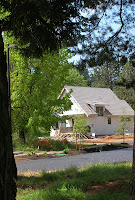The Capital Branch local section of the American Society of Civil Engineers held a field trip and meeting at Pringle Creek Community on May 24. 
A group of 30 engineers, led by President Ken Roley (who is with the City of Salem Public Works), celebrated their 10 year anniversary and presented a a lifetime achievement award to member Ken Archibald, who started his career in civil engineering in 1958. Congratulations, Mr. Archibald.
The meeting included an overview of Pringle Creek by Don Myers. That was followed by Chuck Gregory of W&H Pacific (which created the asphalt mix for Pringle Creek), who did a very interesting presentation on the entire porous street system from an engineer’s technical perspective--soil compaction, rock size, flow and absorption rates, and also the step by step process, innovations, and lessons learned.
That was followed by Chuck Gregory of W&H Pacific (which created the asphalt mix for Pringle Creek), who did a very interesting presentation on the entire porous street system from an engineer’s technical perspective--soil compaction, rock size, flow and absorption rates, and also the step by step process, innovations, and lessons learned.
So, why porous roadways? Pervious concrete and asphalt mimic the natural environment by capturing falling rain, filtering and absorbing it, and recharging the aquifer. This is important because not only does the City need ground water in the summer for human use, wildlife relies on a steady flow of groundwater that is slowly released into watersheds throughout the year, which keeps the streams cool, clean and at normal levels. Porous roadways (and rain gardens) act as giant, spread-out sand filters and phytoremediation (plants + pollution removal) centers for cleaning stormwater on the way to the aquifer. It slows things down and allows bacteria to break down or absorb pollutants.

Conventional impermeable road surfaces, on the other hand, collect non-point source pollution on the road surface--oil and coolant off our cars, heavy metals, like copper dust off brake pads, particulates that settle on the road surface, mercury, spilled gasoline from the mower, you name it--and, then after a storm event carries all that junk directly to our waterways in one big dose of poison. The rapidity of the drainage increases erosion and sediment turbidity. This is a bad deal for fish or wildlife, like crossing a toxic waste dump in a thick haze of smog. Or like swimming through a toilet. In 1999, Salem spilled 127 million gallons of sewage into the Willamette River, mostly after heavy rainfall overwhelmed the system. The Willamette is #3 on the 2006 Most Endangered American Rivers list, thanks mainly to toxic mixing zones, but not helped any by sewer overflows I’m sure.
Pringle Creek Community has the largest neighborhood porous street system in the country. Having engineers, developers, contractors and people who are involved with water quality come out to see our project will hopefully help start a sea change on how streets are made.
--santiago











































